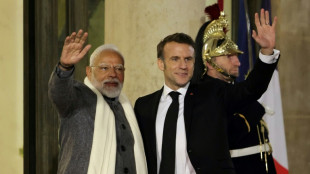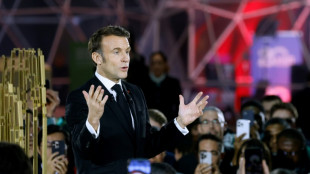
-
 Flattery and pragmatism: UK plan to stay on Trump's good side
Flattery and pragmatism: UK plan to stay on Trump's good side
-
'What would you have us do?': the plastic credits problem

-
 Asian stocks rise as Powell rate warning taken in stride
Asian stocks rise as Powell rate warning taken in stride
-
What are reciprocal tariffs and who might be affected?

-
 AI feud: How Musk and Altman's partnership turned toxic
AI feud: How Musk and Altman's partnership turned toxic
-
US inflation fight to take time in 'highly uncertain' environment: Fed official

-
 Ford CEO says Trump policy uncertainty creating chaos
Ford CEO says Trump policy uncertainty creating chaos
-
Dam fine: beavers save Czech treasury $1 million

-
 Altman says OpenAI 'not for sale' after Musk's $97 bn bid
Altman says OpenAI 'not for sale' after Musk's $97 bn bid
-
Trump says US disaster relief agency should be 'terminated'

-
 'Ridiculous and lame': South Africans mock Trump proposals
'Ridiculous and lame': South Africans mock Trump proposals
-
JD Vance puts Europe, China on notice at AI summit

-
 Global stocks mixed as tariff uncertainty looms
Global stocks mixed as tariff uncertainty looms
-
BP pledges strategic 'reset' as profit tumbles

-
 Gucci owner Kering's annual profit plunges
Gucci owner Kering's annual profit plunges
-
Trump signs orders for steel, aluminum tariffs to start March 12

-
 EU leaders vow 'firm' response to US tariffs
EU leaders vow 'firm' response to US tariffs
-
New Zealand rethinks opposition to deep-sea mining

-
 World leaders seek elusive AI common ground at Paris summit
World leaders seek elusive AI common ground at Paris summit
-
YouTube, the online video powerhouse, turns 20

-
 Playgrounds come alive again with Brazil school phone ban
Playgrounds come alive again with Brazil school phone ban
-
Could a climate megaproject cloud Chile's unparalleled views of universe?

-
 Trump signs executive orders on steel, aluminum tariffs
Trump signs executive orders on steel, aluminum tariffs
-
US judges challenge Trump cuts as legal battles mount

-
 Global stock markets brush off latest Trump tariffs
Global stock markets brush off latest Trump tariffs
-
Macron vows at summit France to 'deliver' on AI acceleration

-
 Steel at heart of new Trump trade war
Steel at heart of new Trump trade war
-
US federal workers weigh Trump buyout as court to step in

-
 McDonald's profits dented by food poisoning outbreak
McDonald's profits dented by food poisoning outbreak
-
Almost half of remote French island hit by wildfire: official

-
 Trump to impose new 25% tariffs on steel, aluminum
Trump to impose new 25% tariffs on steel, aluminum
-
Global stocks markets push higher despite more Trump tariffs

-
 Nestle share slump adds pressure on new boss
Nestle share slump adds pressure on new boss
-
Spain boss Tome denies 'punishing' Hermoso after forced kiss

-
 Global stocks rise despite more Trump tariffs
Global stocks rise despite more Trump tariffs
-
Nokia names Intel's AI head to replace CEO

-
 Trump to impose new 25% tariff on US steel, aluminum imports
Trump to impose new 25% tariff on US steel, aluminum imports
-
Nokia CEO Lundmark to be replaced by Intel AI chief Hotard

-
 Almost all nations miss UN deadline for new climate targets
Almost all nations miss UN deadline for new climate targets
-
Most Asian markets drop as traders weigh Trump's latest tariff salvo

-
 Afghan wedding halls light up sombre Kabul nights
Afghan wedding halls light up sombre Kabul nights
-
Government chiefs and tech leaders gather in Paris for AI summit

-
 Trump says will impose 25% tariffs on US steel, aluminum imports
Trump says will impose 25% tariffs on US steel, aluminum imports
-
Trump says Musk will help uncover 'hundreds of billions' in US govt fraud

-
 Baltic nations 'successfully' link with European power grid
Baltic nations 'successfully' link with European power grid
-
Iranian schools and offices shut as cold snap bites

-
 AI app offers a lifeline for S.Africa's abused women
AI app offers a lifeline for S.Africa's abused women
-
China inflation picks up after Lunar New Year spending boost

-
 Record gold prices both boon and burden for London jewellers
Record gold prices both boon and burden for London jewellers
-
Musk risks putting EU buyers off Tesla: analysts


What are reciprocal tariffs and who might be affected?
US President Donald Trump has threatened to open new fronts in his tariffs war by announcing reciprocal levies on other countries as soon as Tuesday, branding this "the only fair way" to trade.
Trump's fresh salvo could bring a broad tariff hike to emerging market economies like India and take aim at European Union value-added taxes, fanning tensions with the bloc, analysts warn.
- What are reciprocal tariffs? -
Tariffs are taxes imposed on goods imported from another country.
As for reciprocal tariffs -- during election campaigning, Trump promised: "An eye for an eye, a tariff for a tariff, same exact amount."
And on Sunday, he said he would make a detailed announcement on the tariffs on Tuesday or Wednesday, adding that "every country will be reciprocal."
One approach is to hike tariff rates on imports to match the rate that other countries apply to US products, said Goldman Sachs analysts in a note.
Matching this based on different products would raise the United States' average tariff rate by around two percentage points. Doing so to match the average tariff imposed by countries raises the US rate by a smaller amount.
But taking a product-focused approach has complexities.
While Washington has relatively low average tariffs at a 2.7 percent rate in 2022, it has higher rates in "very politically sensitive" areas such as apparel, sugar and pick-up trucks, said Cato Institute vice president of general economics Scott Lincicome.
Similarly, including non-tariff barriers like regulations in the calculus would add to complications.
- Who will be impacted? -
Reciprocal tariffs may open the door to "a broad tariff hike" on emerging market economies who have high duties on US products, JPMorgan analysts expect.
If officials go by average tariff rates applied on all products, countries like India or Thailand -- which tax imports at higher average rates than the United States does -- could be affected.
Trump has previously slammed India as a "very big abuser" on trade and this week, National Economic Council Director Kevin Hassett told CNBC that India had high tariffs that lock out imports.
Lincicome cautioned that high tariffs are often also imposed by poorer countries, who use them as a tool for revenue and protection as they have fewer resources to impose non-tariff barriers like regulatory protectionism.
Goldman Sachs estimates that "there should be no effect on countries with free trade agreements like Mexico, Canada, and Korea, limiting the overall impact" if Washington took a country-based approach to reciprocal tariffs.
- What are the complications? -
It remains unclear if Trump views the policy of reciprocal tariffs as an alternative to a 10-20 percent universal tariff he floated on the campaign trail -- or a separate policy.
One risk is that the Trump administration "could attempt to equalize non-tariff barriers to trade," said Goldman Sachs in a note. In particular, he could consider value-added taxes (VATs) when deciding how much to adjust tariffs.
Doing so stands to raise the average effective tariff rate by another 10 percentage points, Goldman analysts added.
Such a move might also be a response to high European Union VATs, JPMorgan said.
- What is the goal? -
"One of the objectives is to create uncertainty as a negotiating tactic, but uncertainty is a tax on doing business," Jeffrey Schott, senior fellow at the Peterson Institute for International Economics, told AFP.
Unpredictability surrounding tariffs, retaliation and non-trade issues all contribute to a situation that weighs on American and foreign firms, he said.
In the case of allies like Europe, Schott said, US objectives in negotiation could involve "economic and geopolitical priorities, including Ukraine."
They could include finding a better resolution of the situation in Ukraine, which has been fighting off a Russian invasion since 2022, but also to expand US exports in key sectors like LNG.
- Two-way street? -
The United States, however, does not have the lowest tariffs in the world and stands around the middle when it comes to wealthy, industrialized countries, said Cato's Lincicome.
"Should Trump's system be based on average tariff rates, then 'true' reciprocity would require US tariff rate reductions on goods from dozens of countries," he added in a recent report.
A.Zimmermann--CPN
